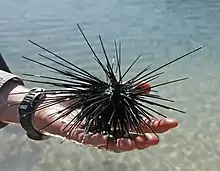| Centrostephanus coronatus | |
|---|---|
 | |
| Centrostephanus coronatus adult | |
.jpg.webp) | |
| Centrostephanus coronatus juvenile | |
| Scientific classification | |
| Domain: | Eukaryota |
| Kingdom: | Animalia |
| Phylum: | Echinodermata |
| Class: | Echinoidea |
| Order: | Diadematoida |
| Family: | Diadematidae |
| Genus: | Centrostephanus |
| Species: | C. coronatus |
| Binomial name | |
| Centrostephanus coronatus | |
| Synonyms | |
| |
Centrostephanus coronatus, also known as crowned sea urchin, is a species of sea urchin in the family Diadematidae. It was first described to science by Yale zoology Professor Addison Emery Verrill in 1867.[2]
Description
The adults are all black, with some blue at the base of the spines. Juveniles have gray bands on their spines. The test is 32 millimetres (1.3 in) to 63 millimetres (2.5 in) in diameter. The spines are thin, hollow, brittle, and very sharp. The longest spines can be 125 millimetres (4.9 in) long. Five clusters of smaller spines surround the mouth on the underside of the test.[3]
Distribution
Crowned sea urchins are found in the eastern Pacific Ocean from Monterey Bay, California to Peru, including the Gulf of California. The species has expanded its range north in recent years.[4] They are also found in the Galapagos Islands. They live from the low-tide line to 125 metres (410 ft) deep.[5] These are bottom dwellers, favoring rocky substrates and reefs.[6]
Life history
This urchin seeks holes and crevices in the bottom when resting. The rock protects them from predators on all sides except the opening of the hole, and the spines guard that. When an individual finds an especially good fitting hole, it can brace its spines against the sides of the rock to resist being pulled out of its niche.[4]
Crowned sea urchins are nocturnal, foraging within a few meters of their shelters, to which they return at dawn.[4][7] They are mostly carnivorous, feeding on sponges, tunicates, bryozoans, and algae.[8]
Crowned sea urchins are gonochoric, which is to say that there are two sexes, and each individual is either male or female. Spawning takes place on a monthly cycle that may be tied to tidal rhythms.[9]
References
- ↑ "Centrostephanus coronatus". Integrated Taxonomic Information System. Retrieved January 19, 2010.
- ↑ Verrill, A. E. (1867). Notes on Radiata in the museum of Yale College. New Haven, Connecticut: Tuttle, Morehouse & Taylor. pp. 295–296.
- ↑ Kerstitch, Alex N.; Bertsch, Hans (2007). Sea of Cortez marine invertebrates : a guide for the Pacific coast, México to Perú (2nd ed.). Monterey, Calif.: Sea Challengers. p. 114. ISBN 978-0-930118-41-9. OCLC 76184242.
- 1 2 3 Freiwald, Jan; Wisniewski, Colleen J.; Abbott, Dan (Spring 2016). "Northward range extension of the crowned sea urchin (Centrostephanus coronatus) to Monterey Bay, California" (PDF). California Fish and Game. 102 (2): 37–40.
- ↑ "Galapagos Species Checklist". Charles Darwin Foundation. Retrieved 2019-12-10.
- ↑ "Centrostephanus coronatus, crowned sea urchin". www.sealifebase.ca. Retrieved 2019-12-11.
- ↑ B. V. Nelson & R. R. Vance (1979). "Diel foraging patterns of the sea urchin Centrostephanus coronatus as a predator avoidance strategy". Marine Biology. 51 (3): 251–258. doi:10.1007/BF00386805.
- ↑ Vance, Richard R. (1979). "Effects of Grazing by the Sea Urchin, Centrostephanus Coronatus, on Prey Community Composition". Ecology. 60 (3): 537–546. doi:10.2307/1936074. ISSN 1939-9170. JSTOR 1936074.
- ↑ Pearse, J. S. (1972-01-01). "A monthly reproductive rhythm in the diadematid sea urchin Centrostephanus coronatus Verill". Journal of Experimental Marine Biology and Ecology. 8 (2): 167–186. doi:10.1016/0022-0981(72)90018-4. ISSN 0022-0981.
External links
- Photos of Centrostephanus coronatus on Sealife Collection